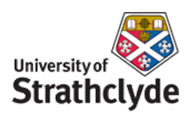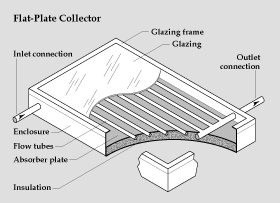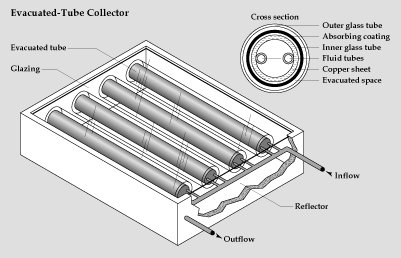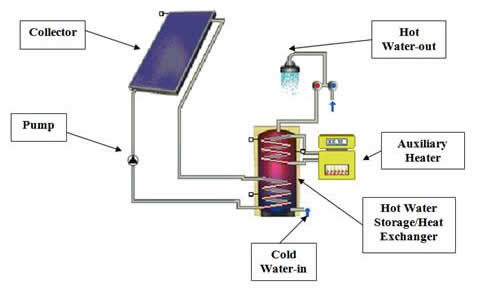


Solar Energy Opportunities in Rural Locations
Solar thermal energy has been used for centuries by the harnessing of solar energy for heating and drying. More recently, in a wide variety of thermal processes, solar energy has been developed for power generation, water heating, mechanical crop drying and water purification among others (Foster R. 2009). The primary uses for solar thermal systems in rural locations are water heating for domestic use and swimming pools; heating of buildings; and evaporative processes (such as distillation and dryers) for agriculture. All of these processes require an operating temperature of less than 100oC; therefore the solar energy flux is enough to elevate the working fluid to the required temperature without needing to concentrate the suns energy (ie. using mirrors or lenses). For these applications, two types of solar collector that can be used are flat-plate and evacuated tube.
Flat-Plate Collectors
Figure 1. Flat-Plate Collector
Source: EERE
Flat-plate collectors consist of a waterproof, metal or fibreglass insulated box containing a dark coloured absorber plate with one or more translucent glazings. A heat-transport fluid flows through a series of tubes to remove heat from the absorber. To protect against freeze damage during winter months, a mixture of water and propylene glycol can be used as the working fluid. Flat-plate collectors can be mounted on a roof, in the roof itself or be freestanding.
Figure 2. Evacuated Tube Collector
Source: EEREEvacuated tube collectors consist of rows of parallel glass tubes connected to a header pipe. The air between the outer and inner glass tubes is removed, reaching vacuum pressures of around 10-5 mbar (DGS, 2005). The vacuum creates high insulation conditions which help to eliminate heat loss through convection and radiation. Therefore, evacuated tube collectors can generally reach higher working fluid temperatures than flat plate collectors; typically in the range of 77-170 oC. Although evacuated tube collectors have a higher efficiency than flat plate collectors (especially where large temperature differences between the absorber and the surroundings exist), they are considerably more expensive and cannot be used for in-roof installations.
Solar Thermal Requirements
The optimum location for a solar thermal collector is a south-facing roof with a large enough area for installation; which is free from shade and has a tilt angle close to that of the latitude. Roofs which are not directly south-facing but are within south-east and south-west are also suitable and collectors can be mounted on brackets if the roof angle is too low.
A typical solar thermal system used for domestic hot water will consist of a collector, hot water store, heat exchanger, auxiliary heater (such as a gas boiler or electric immersion heater), connecting pipes and a pump to circulate the working fluid. The working fluid will typically be a water-glycol mixture circulated in a closed circuit. This type of system (indirect), where the solar circuit is separated from the domestic water circuit, is most suited to temperate climates.
Figure 3. Typical In-direct Solar Thermal System
Source: T*Sol
Environmental considerationsSolar thermal systems are beneficial for the environment as they reduce our dependence on finite energy resources such as coal and gas. In rural locations, mains supply gas is often unavailable and bulk fuels (such as LPG or kerosene) have to be used for providing hot water. The installation of a solar thermal system reduces the need for bulk fuels and therefore reduces carbon dioxide emissions. This actively contributes towards reducing the effects of climate change. The environmental payback time of solar thermal systems is typically 0.5 – 2 years (Corrado B. R, 2005); which is considerably lower than the average lifetime (15 – 20 years). This could further be improved by choosing different materials and components in the production of collectors that are more environmentally friendly. The use of solar thermal systems in rural locations reduces greenhouse gas emissions and contributes to a more sustainable future; adhering to the motto “THINK GLOBALLY – ACT LOCALLY”.
Cost
The typical cost for the installation of a glazed flat-plate solar thermal system is around £700 per m2 of collector area. For evacuated tube collectors this goes up to around 1050 m2 (Energy Savings Trust). Typically, a solar thermal system can provide around a third of the hot water heat requirement for a typical 3 bedroom detached house (in a temperate climate like the UK). This reduces water heating bills by between £50 and £85 per year and can save up to 580 kg in CO2 emissions dependent upon what fuel is replaced. Maintenance costs are generally very low and, if installed properly, will only require thorough checks every 3 – 5 years.
References
- Solar Energy: Renewable Energy and the Environment. Foster R, Ghassemi M, Cota A. CRC Press. 2009.
- Planning and Installing Solar Thermal Systems: A Guide for Installers, Architects and Engineers. DGS (The German Solar Energy Society), Ecofys. 2005.
- Environmental Assessment of Solar Thermal Collectors with Integrated Water Storage. Battista R. Corrado A. University of Rome. 2005.
- Environmental benefits of domestic solar energy systems. Kalogirou S.A. HTI Cyprus. 2003.
- http://www.energysavingtrust.org.uk/Generate-your-own-energy/Solar-water-heating

| MSc: Renewable Energy Systems and the Environment | © University of Strathclyde 2010 |


